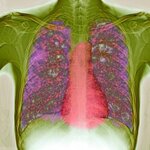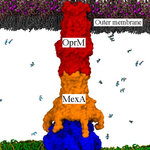Microbiology

New molecules similar to carbohydrates have showed the capacity to inhibit the activity of a specific type of glycoside enzymes - and that means inhibiting infectious diseases.
Glycosides are essential enzymes to digest carbohydrates but they are also key players in infections caused by pathogens, in anti-bacterial defense and many other vital cellular processes. Because these small molecules that are able to bond with and inhibit the activity of enzymes in infectious diseases, it opens up the basis for new medicines.
“We have synthesized new molecules, taken new measurements of their…

If you’ve ever thought your poo is just a bunch of dead cells, think again. Most of it is alive, teeming with billions of microbes. Here’s what studies in healthy adults reveal makes up our poo.
Water
Our feces is largely (75%) made up of water, although this differs from person to person.
Vegetarians have a higher water content in their stools. Those who consume less fiber and more protein have a lower water content. Fiber has a high water-carrying ability and makes our stools more bulky, increases the frequency of bowel movements and makes the process of passing bowel motions easier.
The…

Bt modification in maize does not affect non-target beneficial microorganisms such as endophytes, according to a new study. This debunks some of the more obscure claims made by activists opposed to genetic engineering (suicides in India being the most bizarre.
Genetically modified Bt corn contains a gene from the soil bacterium Bacillus thuringiensis (Bt) which provides resistance to major insect pests. Bt maize is one of the most popular GM crops in the world, but environmental groups still insist little is known about potential impacts on ecosystem functionalities. Ironically…

Enterotoxigenic Escherichia coli is a major cause of diarrhea in developing countries, and responsible for at least 300,000 deaths a year, according to the World Health Organization.
Effective vaccines have not been developed, so patients infected are treated with antibiotics and supporting measures. The emergence of multidrug-resistant bacteria has become a concern so the development of new treatment methods is ongoing.
One approach the science community is taking is lowering adherence to the host intestinal epithelium, an essential step for ETEC infection in humans. It was thought that a…

If you want to understand the spread of antibiotic resistance across Europe, sexually transmitted diseases seem to be a decent barometer.
Gonorrhea,
caused by the bacterium Neisseria gonorrhoeae, is the second most prevalent bacterial sexually transmitted disease globally. The WHO estimates that Gonorrhea infects 88 million people globally each year. Amongst other complications, it can cause pelvic inflammatory disease and infertility if left untreated, and in some cases leads to life-threatening complications such as meningitis. Transmitted during unprotected sex, many strains of Gonorrhea…

American government-funded science likes to declare wars. War on cancer, war on obesity, during the Obama administration there were seven different "Manhattan Projects" related to science and health. It connotes action, it makes the public feel like something important is happening with taxpayer money, revolutionary, instead of being iterative and slow.
Plants are more practical. They developed an evolutionary strategy to "tolerate" rather than "resist" infection to maintain health. And that may be the roadmap for tuberculosis.
Since the discovery of Mycobacterium tuberculosis, or…

Pelleh Farms of Swan Lake, New York has recalled its Pasteurized Whole Organic Milk Non-Homogenized products due to improper pasteurization.
At least it was almost pasteurized. In the demographic that thinks organic food is good, vaccines are bad, and science stopped at 1860, raw milk is on trend. They intentionally go without pasteurization in the belief that it contains more nutrients than safe milk.
Proper pasteurization heats milk to 161 degrees Fahrenheit to effectively eliminate all pathogenic bacteria, such as Listeria and Salmonella. Raw milk chooses to let such bacteria remain…

Raw milk, which has been known for over a century to substantially increase the risk for bacterial illness, has led to another permanent government-ordered shutdown.
The U.S. District Court for the Northern District of New York entered a consent decree of permanent injunction against Vulto Creamery LLC of Walton, N.Y. so that they cannot prepare, process, manufacture, pack and/or hold FDA-regulated food products until they can ensure that Listeria monocytogenes, which can cause a rare but potentially life-threatening illness, is not present in their facility and their food.
The company…

A new "raw" trend has made its way into the paper of record for anti-science woo and miracle vegetable fads - the New York Times.
Along with articles about astrology and acupuncture, they have now given us a look at the "raw water" craze, which is to say they have basically created the craze by giving it free publicity, which they can then write about it for their audience which, let's be honest, loves anything alternative, especially if it's against evil corporate or government science water.
They even endorse wacky charlatan Doug Evans, who rewarded shareholders stung by the failure of his…

Transport proteins called efflux pumps, and their role in creating drug-resistance in bacteria, could lead to improving effectiveness of drugs against life-threatening diseases and perhaps even bring defunct antibiotics back to prominence.
Some life-threatening infections do not respond to antibiotics because efflux pumps inside a particular type of infectious microbe called Gram-negative bacteria flush out antibiotics before the drugs can work. One type of efflux pump, which until recently had only been studied in parts, was recently modeled in its entirety and simulated using supercomputers…